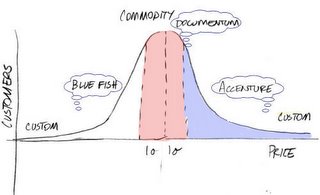- Case studies of companies that buy "hump" solutions, but used Blue Fish.
- Customer presentations at “hump” company events.
- An online community that targets developers of "hump" company products.
- Co-marketing with “hump” companies.
Tuesday, December 06, 2005
Killing Sacred Cows
"Spend some time denigrating the status quo" if you hope to build support for a new initiative, advises Seth Godin in his book Free Prize Inside. You've got to hack through the walls called "this is how we do it" to get to "this is how we could do it."
Here's how I presented a strategy shift in Blue Fish's approach to communication.
Blue Fish was marketing as if they were the big horizontal software company in their market, EMC|Documentum. The benefits talked about in their marketing literature were rife with unprovable claims, broad promises and self-aggrandizing prose. Blue Fish is a consultancy, not Documentum. I argued that they are a long tail company. Each solution is unique. Each customer wants to codify their own unique way of doing things. Ultimately their solutions will be bred from something that has been done before, but this doesn't mean they're looking for a one-size-fits-all answer.
I felt that the shift to a long tail strategy required a focus on Blue Fish's capabilities more than the benefits of the solutions they deliver. The benefits of an ECM solution are well known to those who suffer without them. The Blue Fish differentiator wasn't in selling Web content management solutions "that empower business users to manage their own Web content," it was in the team; the consultants and methodologies that allowed them to create solve their clients’ problems.
The first thing I did was to clip marketing messages from the web sites of several Blue Fish competitors. I read each one aloud and challenged the team’s veterans to name the competitor. They actually did better than I thought--they got 1 in 3 right as I remember.
Then I read the last one. They couldn't place it. When I told them it was from the Blue Fish web site, I had their full attention. The status quo had taken a mortal blow.
I then said that we would start with a lesson in Marketing 101. I drew an image like the following on the whiteboard:
“The role of a marketer,” I began, “is to find the largest markets and serve those customers’ needs.” If you graph the price of a solution against the number of customers who will pay that price, you will get a normal distribution in any reasonably sized market. The marketer then locates the highest point on that graph, takes a standard deviation in each direction, and focuses on selling products that solve those problems. This strategy makes immediate sense to almost anyone, and will kill Blue Fish if they employ it.
A company with the resources of a Blue Fish will find itself handily beaten by larger competitors with a strategy like this. The hump is commodity. The hump is horizontal solutions. The hump is image marketing and advertising. Blue Fish has no place in the hump. The tail is premium pricing. The tail is specialized solutions. The tail is conversations and interactions. These are the waters in which Blue Fish thrive.
To making a long-tail strategy work you must have a mechanism that moves prospects from the hump down into the tail. They know the companies that live in the hump. How will you guid them down into the tail where they will find the less known species? Amazon uses its “shoppers who bought this item also bought…” strategy to make you aware of items that are out in the tail. But what does a small consulting company use to move people from the hump, where EMC Documentum rules to the tail where they rule?
Subscribe to:
Post Comments (Atom)

No comments:
Post a Comment